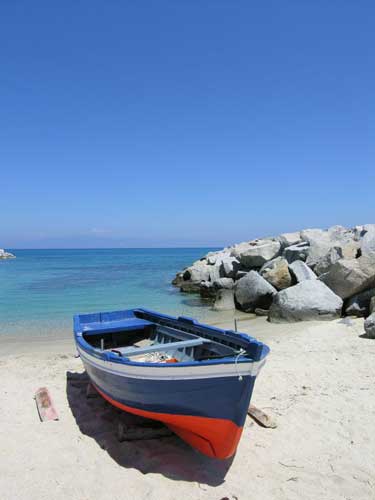Please adjust your watch to Calabrian time
You've visited the heel of Italy's boot? Now, take a tour of its toe, says Cahal Milmo

Your support helps us to tell the story
From reproductive rights to climate change to Big Tech, The Independent is on the ground when the story is developing. Whether it's investigating the financials of Elon Musk's pro-Trump PAC or producing our latest documentary, 'The A Word', which shines a light on the American women fighting for reproductive rights, we know how important it is to parse out the facts from the messaging.
At such a critical moment in US history, we need reporters on the ground. Your donation allows us to keep sending journalists to speak to both sides of the story.
The Independent is trusted by Americans across the entire political spectrum. And unlike many other quality news outlets, we choose not to lock Americans out of our reporting and analysis with paywalls. We believe quality journalism should be available to everyone, paid for by those who can afford it.
Your support makes all the difference.Goats and motorways rarely combine well – except, that is, on the sun-kissed trunk roads of Calabria. Every afternoon, the Pizzo intersection of the A3 autostrada that shuttles Alfa Romeos and juggernauts along the length of the mountainous region that forms the "toe" of Italy's "boot" is brought to a halt by a herd of 200 goats moving from pasture to an adjoining dairy.
The shepherd in charge of this daily ceremony puts his hand up to the traffic and waves his bleating charges across the asphalt while the traffic patiently waits without even an impatient beep. It is a daily ritual which speaks volumes about life in mainland Italy's southernmost region. Calabria, with its 600 miles of Mediterranean coastline and a hilly, lush interior, still has a profound respect for a slower way of doing things.
In its small, often tumble-down towns and villages, the four-hour lunch break is rigorously enforced. The hours between 12.30pm and 4.30pm are strictly reserved for sitting down for a glass of peppery wine and a plate of Calabria's hearty "national dish", pasta alla Norma – aubergines in tomato sauce with grated boiled egg, basil and ricotta cheese.
While Tuscany can point to its Renaissance treasures, the Calabrians patiently explain the widespread evidence in their province of great and ancient civilisation. The Bronzi di Riace – full-size bronzes of Greek warriors found in the sea and on display in Reggio di Calabria, the regional capital – and the archaeological jewels of Locri Epizefiri, a walled Greco-Roman town – are held up as proof of Calabria's status as the cradle of Italian civilisation. It is no coincidence that Calabria's first indigenous tribe was called the Itali.
Above all, Calabria, with its turquoise waters, hidden coves and ancient villages, is a place that rewards curiosity. Although their compatriots have long since discovered the region's charms, it remains largely undiscovered by foreigners. The region, one of Italy's poorest, is taking a new-found pride in the myriad treasures that have survived down the ages, cut off from the coach-party hordes by miles of twisting country roads.
A drive through vistas that range from beaches lined with palm trees to olive groves and meadows at altitudes of up to 4,000ft dotted with cherry and almond orchards is rewarded by happening upon places such as Squillace on Calabria's east coast. This tiny hill town with a cathedral and Norman castle is home to a community of pottery workers making pignatari, a form of painted terracotta. Working in small co-operatives, their products can be bought only from the studios in the village.
Travellers seeking an authentic taste of the region should head for the agriturismi, or farm-based guest houses, many of which can be rented through southern Italy specialist Long Travel. At Basillani (also known as I Monaci after the 11th-century Orthodox monastery it once housed), guests are served a tantalising combination of the wisdom of its owner, Marina Martelli, and home-cooked Calabrian food from a cuisine dominated by fresh vegetables, chilli and acorn-fed pork.
Marina, the daughter of a famous Calabrian microbiologist who returned from Rome 14 years ago to run Basillani, is a firm advocate of the serendipitous approach to her adopted homeland. She said: "The history of Calabria is the history of living on the margins. We were squeezed between the sea and mountains, between kings and pirates and Europe and Africa.
"Today you have not got the richest place in Europe but a very unspoilt place. You must go and look for Calabria. You must go to the pastry shops, stop at the fruit stalls on the road and knock on the church doors. But you will be rewarded by some of the most hospitable and generous people you can find. It is a place to move slowly, stop and look."
This is borne out on the Violet Coast, named after its dramatic sunsets. The ancient towns of Pizzo and Tropea perch on cliffs overlooking some of the pristine beaches that bring Italians flocking here. In the main square of Pizzo, everyone gathers for the evening passeggiata. Every now and again, a freshly caught swordfish is brought into the fishmonger. Like the crossing of the goats, it is a process which requires the traffic to stop. And the Calabrians do stop and watch.
COMPACT FACTS
How to get there
Cahal Milmo travelled to Calabria as a guest of Long Travel (01694 722193; long-travel.co.uk), which offers a week's rental of a self-catering apartment at I Monaci from £595, including hire car, or half-board in a double room from £336 per person, per week. Return flights to Lamezia Terme with Ryanair (0871 246 0000; ryanair.com) cost from £208. Carrental.co.uk offers a week's car hire from £146.
Join our commenting forum
Join thought-provoking conversations, follow other Independent readers and see their replies
Comments